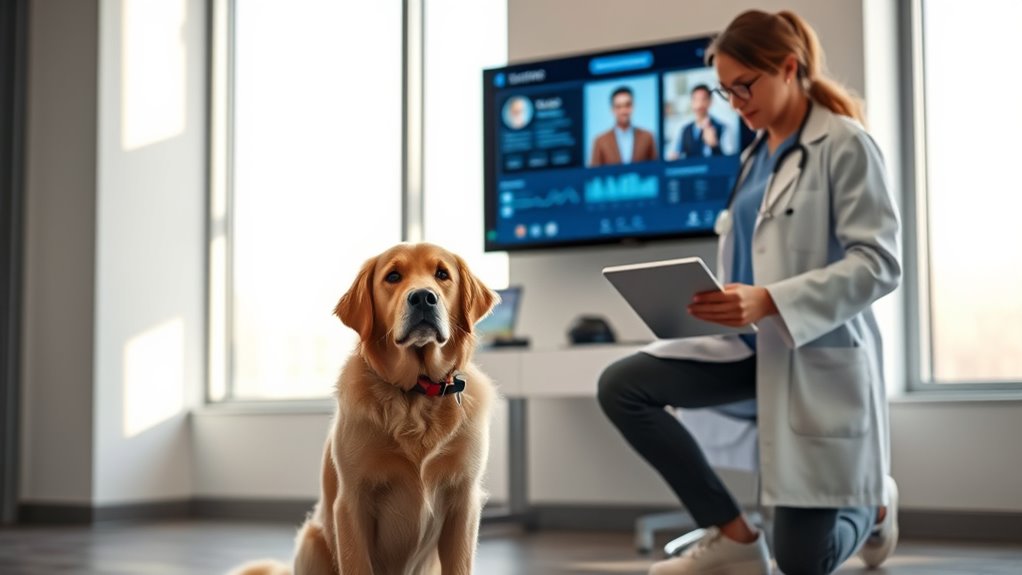Pet telemedicine is rapidly growing, offering you easier access to veterinary care, cost savings, and quick emergency support. It lets you schedule appointments hassle-free and consult remotely, saving time and travel costs. However, there are limitations, like less accurate diagnoses without physical exams and privacy concerns. Understanding both the benefits and challenges helps you make informed choices—stay with us to explore how this evolving field impacts your pet’s health care.
Key Takeaways
- Telemedicine enhances accessibility and convenience for pet owners by enabling quick, remote consultations without leaving home.
- It offers cost savings and immediate emergency guidance, reducing the need for unnecessary travel and in-clinic visits.
- Limitations include diagnostic challenges without physical exams and potential data security risks.
- Ethical concerns involve ensuring animal welfare, informed consent, and maintaining privacy and data security.
- Future innovations in diagnostics and AI will further improve remote veterinary care, expanding telemedicine’s pros while addressing current cons.
The Growth of Virtual Veterinary Services
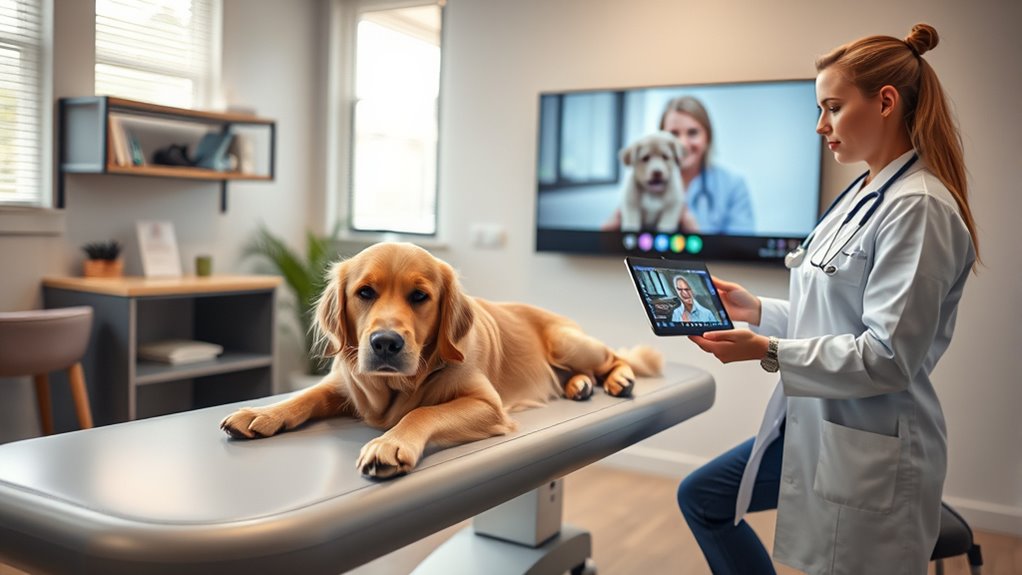
Have you noticed how virtual veterinary services are rapidly expanding? This growth is fueled by easier access to veterinary licensing, allowing licensed vets to offer remote consultations across wider regions. As a pet owner, you might find more providers now offering telemedicine options, making it convenient to get advice without visiting the clinic. Insurance coverage is also evolving, with some plans beginning to include virtual visits, reducing out-of-pocket costs. These developments ensure that your pet’s health needs are more accessible than ever before. Additionally, understanding business regulations that support telehealth services can help you navigate available options more effectively. However, it’s essential to verify that the veterinarian is properly licensed in your state to ensure quality care. Overall, this expansion enhances the reach of veterinary services, making pet health management more flexible and efficient.
Accessibility and Convenience for Pet Owners

Pet telemedicine makes scheduling appointments quick and hassle-free, safeguarding you time and effort. With remote care options, you can consult your veterinarian without leaving home. This convenience helps guarantee your pet gets prompt attention whenever you need it. Additionally, it can help address emotional support needs by providing reassurance and guidance during stressful situations.
Easy Appointment Scheduling
Thanks to telemedicine, scheduling appointments has become much easier and more convenient for pet owners. You no longer need to wait on hold or juggle busy schedules to see your veterinarian. Online platforms offer appointment flexibility, allowing you to choose times that fit your routine. This increases scheduling efficiency, as you can book, reschedule, or cancel with just a few clicks. Telemedicine services often provide quick confirmation, reducing the wait time and making it simple to plan visits around your day. With streamlined scheduling, you spend less time coordinating and more time caring for your pet. Overall, telemedicine simplifies the process, giving you more control and ensuring your pet gets timely attention whenever you need it. Understanding size restrictions for tiny houses can also help you better plan your pet-friendly living space if you choose a tiny home.
Remote Care Accessibility
With streamlined appointment scheduling making visits more convenient, accessing veterinary care remotely further enhances how easily pet owners can get help. Telemedicine platforms improve remote care accessibility by allowing you to consult licensed veterinarians without leaving home. This increases the reach of pet owner education, helping you better understand your pet’s health needs. However, it’s essential to ensure that vets are properly licensed in your state, as veterinary licensing standards vary. Remote care eliminates travel time and reduces stress for your pet, making urgent consultations more accessible. It also benefits those in rural or underserved areas, who might otherwise struggle to find immediate care. Additionally, the vet’s ability to evaluate vetted information about your pet’s condition remotely can lead to quicker, more accurate assessments. Overall, telemedicine makes veterinary support more convenient and accessible, empowering you to actively participate in your pet’s health management.
Cost-Effectiveness of Telemedicine for Pets
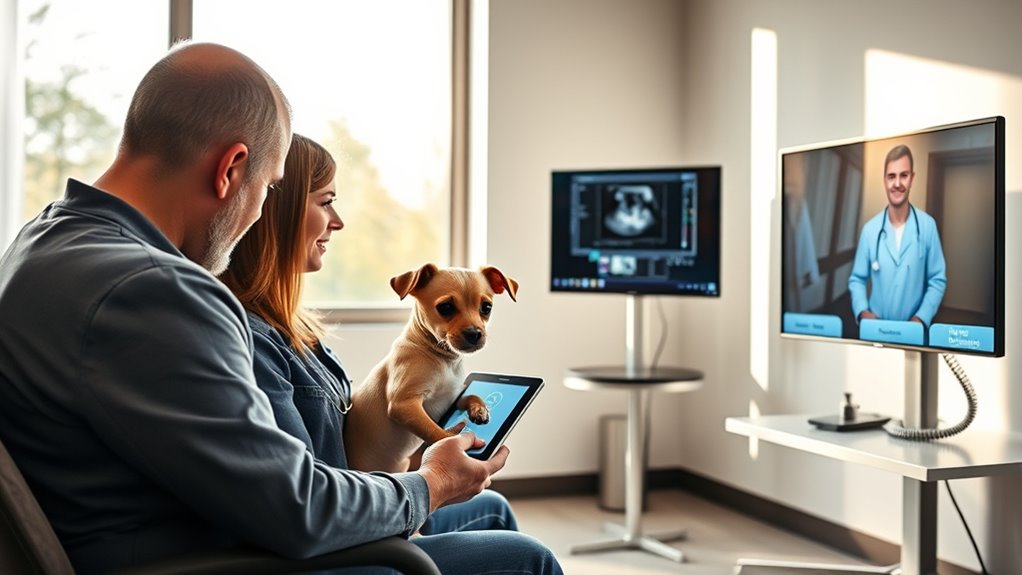
Telemedicine for pets can particularly reduce costs for pet owners by eliminating the need for in-person visits, which often involve travel expenses and time off work. This improves overall affordability and makes veterinary care more accessible. A thorough understanding of city dynamics can help owners better navigate local resources and support networks. Here’s how telemedicine boosts cost-effectiveness:
- Lower consultation fees—virtual visits are typically less expensive than in-clinic appointments.
- Eliminates travel costs—you save on transportation and fuel.
- Reduces time off work—less missed hours means fewer income disruptions.
- Prevents unnecessary visits—quick virtual assessments can avoid costly emergency trips.
Enhancing Emergency and Urgent Care

Emergency and urgent care for pets can be considerably improved through telemedicine by providing immediate access to veterinary advice when every second counts. Telemedicine allows you to quickly assess your pet’s condition, guiding you on whether urgent in-person care is necessary. It also helps in addressing issues like pet nutrition, ensuring your pet receives the right diet during emergencies, and offering behavioral training advice to manage stress or anxiety that may worsen a crisis. This rapid support can stabilize your pet before visiting a clinic, potentially saving lives. Plus, veterinarians can remotely evaluate symptoms, suggest first aid, and determine if hospitalization is needed. Additionally, antioxidants found in certain honey varieties can support your pet’s immune response during recovery. By integrating telemedicine into emergency protocols, you gain a crucial tool to enhance your pet’s safety and well-being during critical moments.
Limitations and Challenges of Remote Consultations
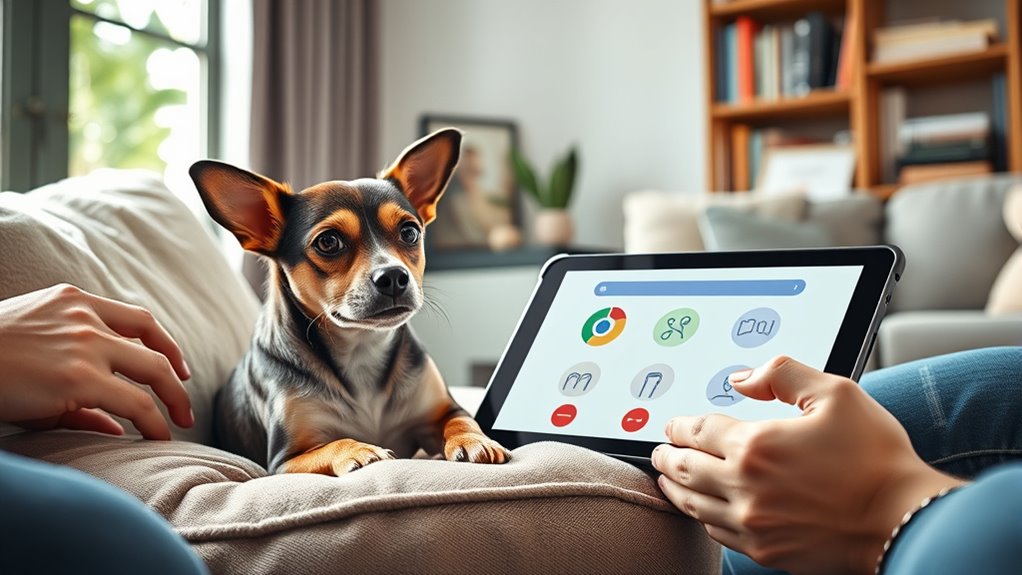
While remote consultations offer convenience, they also come with notable limitations. Technological limitations can hinder the quality of care, making it difficult to assess pets accurately. Diagnostic accuracy is often compromised because vets can’t perform physical exams or observe subtle physical cues. Here are some key challenges:
Remote vet consultations can limit accurate assessments and diagnostics for your pet.
- Limited ability to evaluate physical symptoms effectively
- Dependence on high-quality video and internet connectivity
- Inability to perform hands-on diagnostics like palpation or blood tests
- Potential for misdiagnosis due to incomplete information
- Vetted quality products and services are essential to ensure safety and effectiveness in remote care.
These issues highlight that, despite benefits, remote consultations may not always deliver the precise, thorough care your pet needs. Recognizing these hurdles helps you understand when an in-person visit is essential.
Impact on Traditional Veterinary Practices
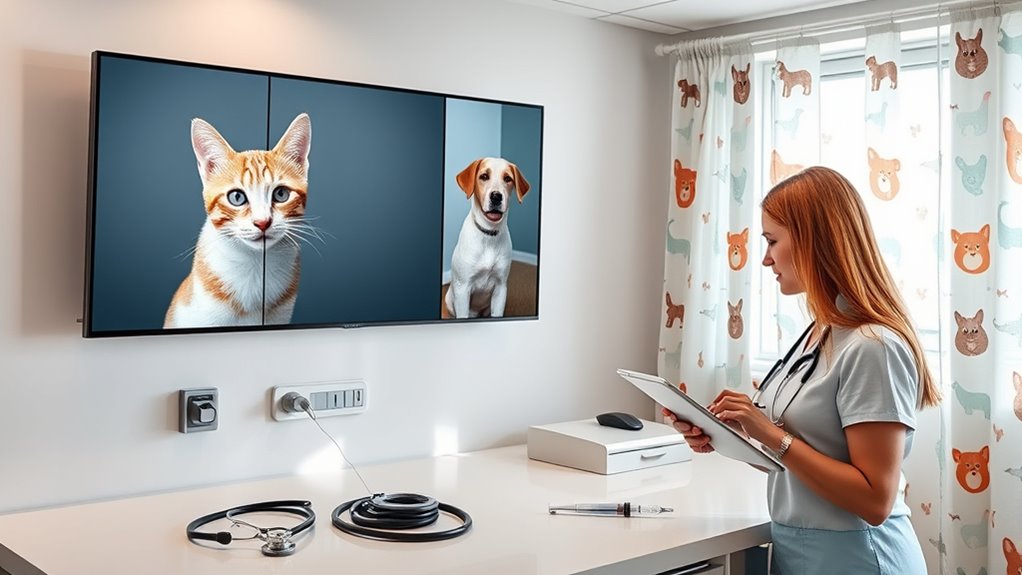
Remote consultations are reshaping how veterinary clinics operate, prompting many practices to reconsider their traditional models. You might find that telemedicine enhances client pet relationships by offering convenience and faster access to care, but it also challenges the way vets establish trust and gather thorough information. Traditional in-person visits allow for detailed examinations, which remain essential for accurate diagnoses and treatments. Meanwhile, veterinary licensing requirements can complicate remote care, especially when consultations cross state or country borders, potentially limiting your ability to serve certain clients. As telemedicine grows, practices must adapt by balancing digital convenience with maintaining quality care and strong client relationships. This shift encourages you to rethink workflows, emphasize communication, and navigate licensing regulations carefully. Incorporating professional voice talent in your educational materials can also improve client understanding and engagement with telemedicine services.
Privacy and Data Security Concerns
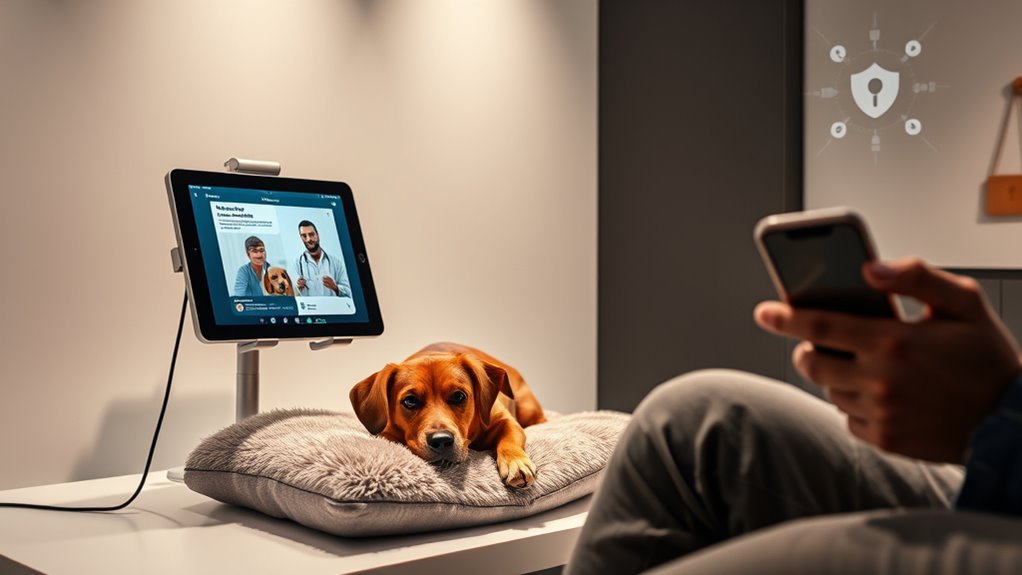
As you use pet telemedicine services, you should be aware of the risks of data breaches that could expose sensitive information. Ensuring your personal details are protected requires understanding the security measures these platforms have in place. Staying informed helps you make safer choices for your pet’s healthcare and your privacy. Regularly reviewing the platform’s security protocols can help safeguard your data from potential threats.
Data Breach Risks
Data breaches pose a significant concern in pet telemedicine, as sensitive pet health information can be targeted by cybercriminals. These cybersecurity threats can compromise your data, leading to unauthorized access and misuse. To protect yourself, be aware of potential risks:
- Hackers exploiting vulnerabilities in telemedicine platforms.
- Unsecured networks that allow data interception.
- Phishing scams targeting pet owners or providers.
- Data breaches resulting from weak passwords or outdated security measures.
- Recognizing privacy and data security concerns is essential for maintaining trust and confidentiality in digital pet healthcare services.
A single data breach can expose confidential pet health records, risking identity theft or fraud. Staying vigilant and understanding these cybersecurity threats helps minimize risks. Always ensure your platform uses robust security protocols and remains up-to-date to safeguard your pet’s health information.
Personal Information Safeguards
Protecting your pet’s personal information is essential when using telemedicine services, as sensitive data like medical history, owner details, and payment information can be vulnerable to misuse. Ensuring robust safeguards for veterinary data helps maintain pet confidentiality and prevents unauthorized access. Reputable telemedicine providers use encryption and secure servers to protect your information during transmission and storage. Always review privacy policies to understand how your data is handled and whether it’s shared with third parties. You should also confirm that the platform complies with data protection regulations. By staying informed and vigilant, you can help safeguard your pet’s veterinary data, ensuring that their health records and personal details remain confidential and protected from potential breaches or misuse.
Ethical Considerations in Pet Telehealth

Ethical considerations in pet telehealth center on ensuring that virtual care prioritizes the well-being of animals while respecting the responsibilities of pet owners and practitioners. You must guarantee informed consent, making sure pet owners understand the limitations and scope of virtual consultations. Animal welfare remains the core focus, requiring you to assess whether telemedicine provides adequate care or if an in-person visit is necessary.
Key ethical points include:
- Obtaining clear informed consent before treatment.
- Recognizing when in-person care is essential for animal welfare.
- Maintaining honest communication about diagnoses and limitations.
- Respecting privacy and data security for pet owners.
Balancing these factors helps uphold ethical standards in pet telehealth.
Future Trends and Innovations in Pet Telemedicine

As technology continues to evolve, the future of pet telemedicine is poised to become more sophisticated and accessible. Expect significant technological advancements, such as improved diagnostic tools, AI-driven symptom analysis, and high-resolution imaging, which will enhance virtual consultations. These innovations will enable vets to deliver more accurate diagnoses remotely, reducing the need for in-person visits. Additionally, veterinary education will adapt, incorporating telehealth best practices and new digital tools to guarantee veterinary professionals stay current. As a pet owner, you’ll benefit from more seamless, real-time access to veterinary expertise, making pet care more convenient and proactive. These trends will help bridge gaps in veterinary services, especially in remote areas, while fostering continuous improvement in animal health and well-being.
Frequently Asked Questions
How Do Veterinarians Diagnose Complex Conditions Remotely?
When you ask how veterinarians diagnose complex conditions remotely, they rely on remote diagnosis tools like high-quality photos, videos, and detailed histories you provide. They use technology to analyze symptoms, but face limitations because they can’t perform physical exams or tests. To overcome technology limitations, vets often recommend in-person visits for a thorough assessment, ensuring they accurately diagnose and treat your pet’s complex health issues.
Are Pet Telemedicine Services Regulated or Licensed?
Imagine a lighthouse guiding ships safely through foggy waters; that’s how pet telemedicine services are governed. They must follow strict regulatory standards and licensing requirements to guarantee quality and safety. These rules act as a beacon, protecting pet health and owner trust. While regulations vary, most regions require vet licensing and adherence to professional guidelines, helping ensure that remote consultations are safe, effective, and trustworthy for your furry friends.
What Qualifications Should I Look for in a Tele-Vet?
When choosing a tele-vet, look for qualifications that guarantee quality care. Verify they have proper licensing and experience in virtual exam procedures, which are crucial for accurate diagnoses. Good client vet communication is also essential; the vet should be clear, responsive, and willing to address your concerns. These factors help ensure you receive safe, effective care for your pet, even through a screen.
Can Telemedicine Replace In-Person Veterinary Visits Entirely?
You wonder if telemedicine can fully replace in-person vet visits. While it’s great for routine check-ups and veterinary telemonitoring, it can’t handle emergencies or complex procedures. Emergency preparedness remains essential, so in-person visits are still necessary for urgent issues. Telemedicine complements traditional care, offering convenience and monitoring, but it shouldn’t entirely replace hands-on examinations when your pet needs immediate or specialized attention.
How Is Patient Confidentiality Maintained During Virtual Consultations?
Think of virtual consultations as a delicate dance, where maintaining patient confidentiality is key. You guarantee data privacy by using secure, encrypted platforms that protect sensitive information. Confidential communication is preserved through private settings, password protection, and clear policies on data handling. By following these steps, you create a safe space where pet owners can freely share details, knowing their information stays confidential—like a secret garden shielded from prying eyes.
Conclusion
As pet telemedicine continues to grow, it’s transforming how you care for your furry friends. Did you know that the global pet telehealth market is expected to reach $3 billion by 2025? While it offers unmatched convenience and quick access, remember its limitations and privacy concerns. By staying informed and balancing technology with traditional vet visits, you can make certain your pet gets the best care now and in the future.
